Tweaks to making a Gunter Körber bass shawm playable
On acquisition about 40 years ago, this seemed to have the bones of a usable instrument
but a series of small and larger alterations were made to improve its playability and
practicality. These alterations were spaced out cumulatively over around 30 years.
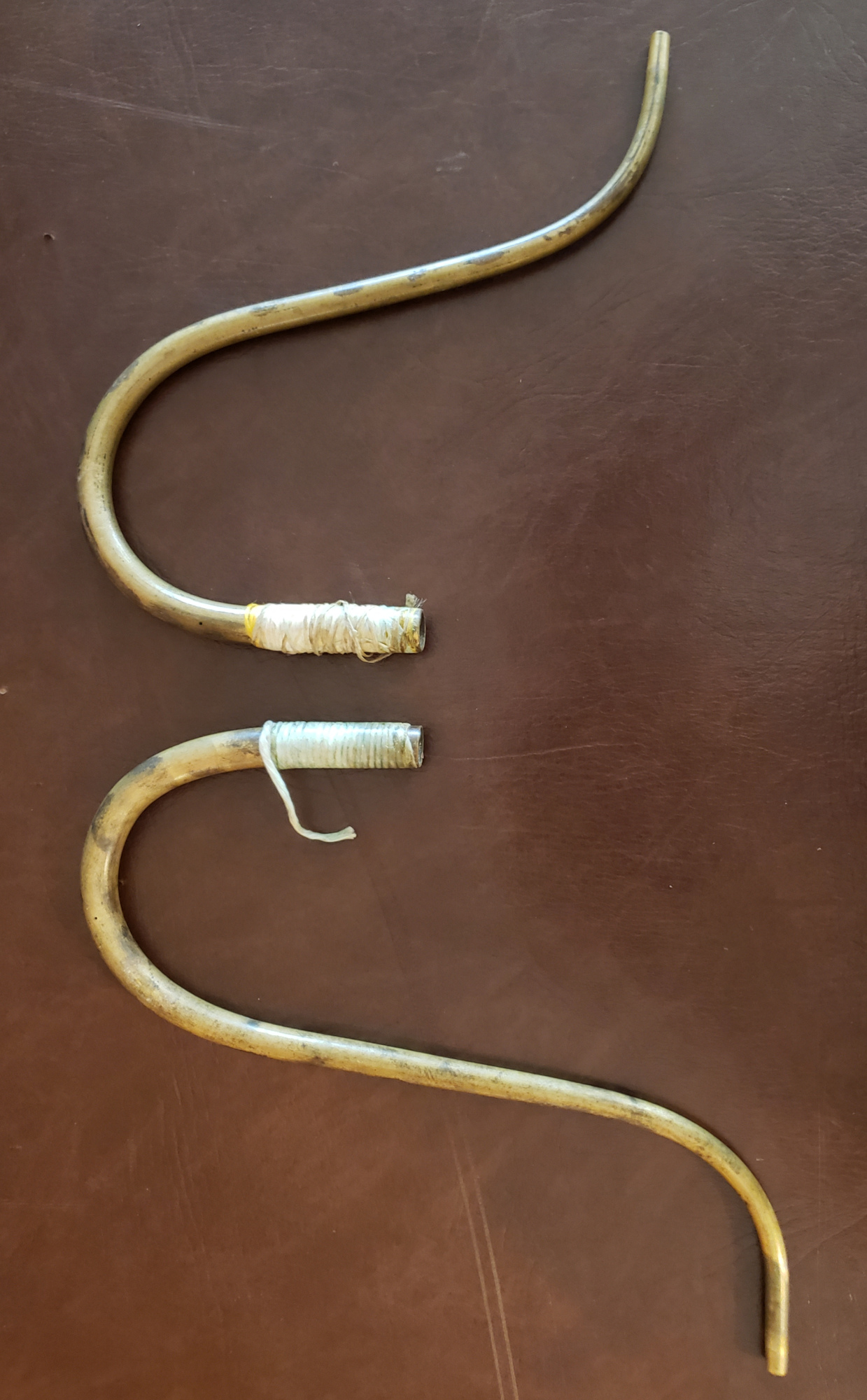 The instrument was purchased at auction lacking a crook.
The first step was to have an instrument-maker make a crook, with a guess made as to the
needed length. The crook obtained resulted in the instrument playing quite sharp, so big reeds were
made to pull the pitch down somewhat. The lowest note C was a bit flat relative to
the general pitch so additional bell-hole drillings were tried to raise that note.
Some years later a "factory" crook was bought from Volker Kernbach
in Celle, which got the instrument closer to A=440.
The curvature of this factory crook was all
wrong (for me) so it was filled with Woods metal and bent to a more ergonomic curve.
The instrument was purchased at auction lacking a crook.
The first step was to have an instrument-maker make a crook, with a guess made as to the
needed length. The crook obtained resulted in the instrument playing quite sharp, so big reeds were
made to pull the pitch down somewhat. The lowest note C was a bit flat relative to
the general pitch so additional bell-hole drillings were tried to raise that note.
Some years later a "factory" crook was bought from Volker Kernbach
in Celle, which got the instrument closer to A=440.
The curvature of this factory crook was all
wrong (for me) so it was filled with Woods metal and bent to a more ergonomic curve.
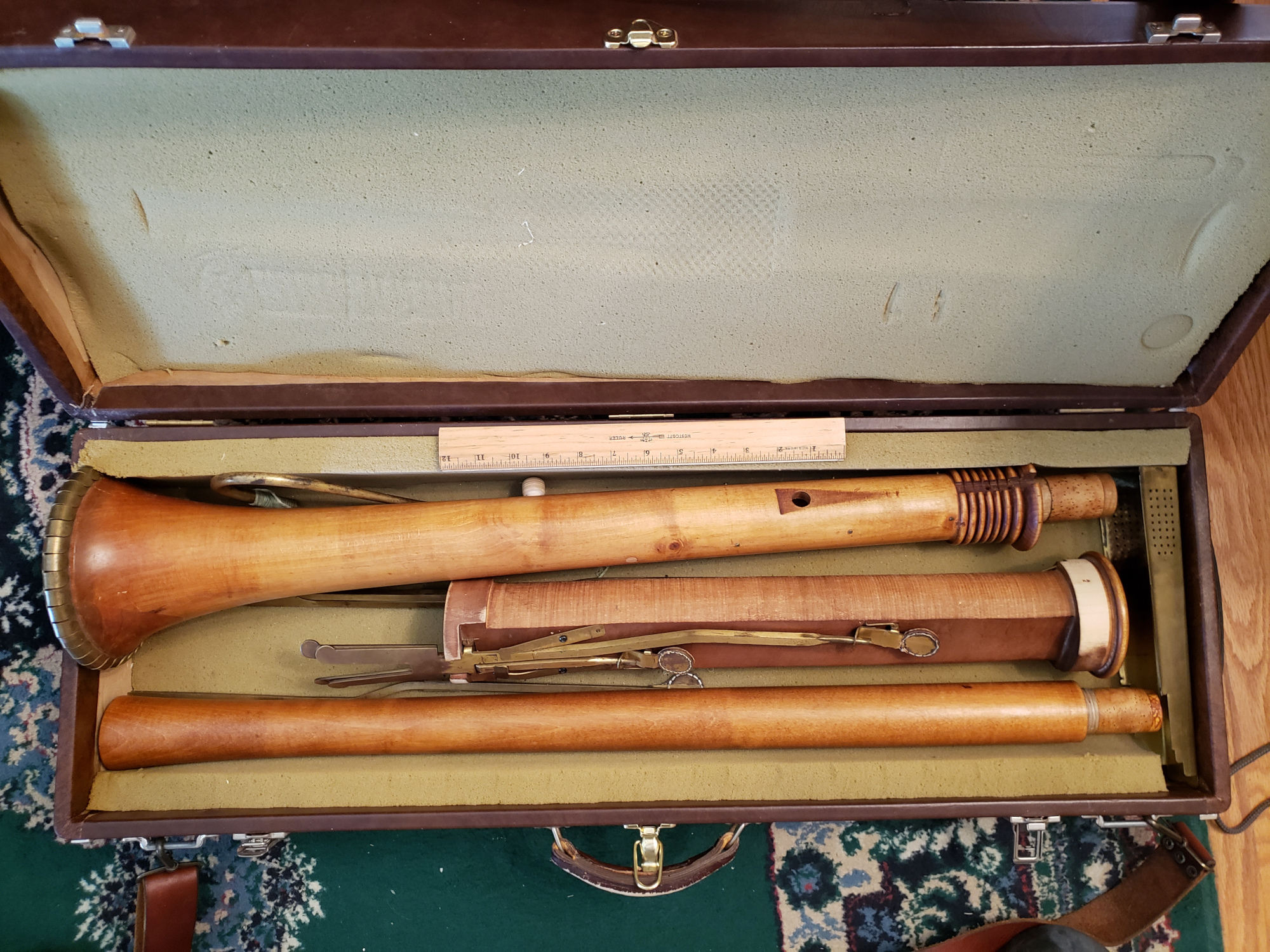 There was one tenon for disassembly located
above the fontanelle. This still left the lower 2/3 of the instrument in one piece.
A second tenon was created below the fontanelle to allow breakdown into 3 parts suitable for transport in a
smaller custom case.
There was one tenon for disassembly located
above the fontanelle. This still left the lower 2/3 of the instrument in one piece.
A second tenon was created below the fontanelle to allow breakdown into 3 parts suitable for transport in a
smaller custom case.
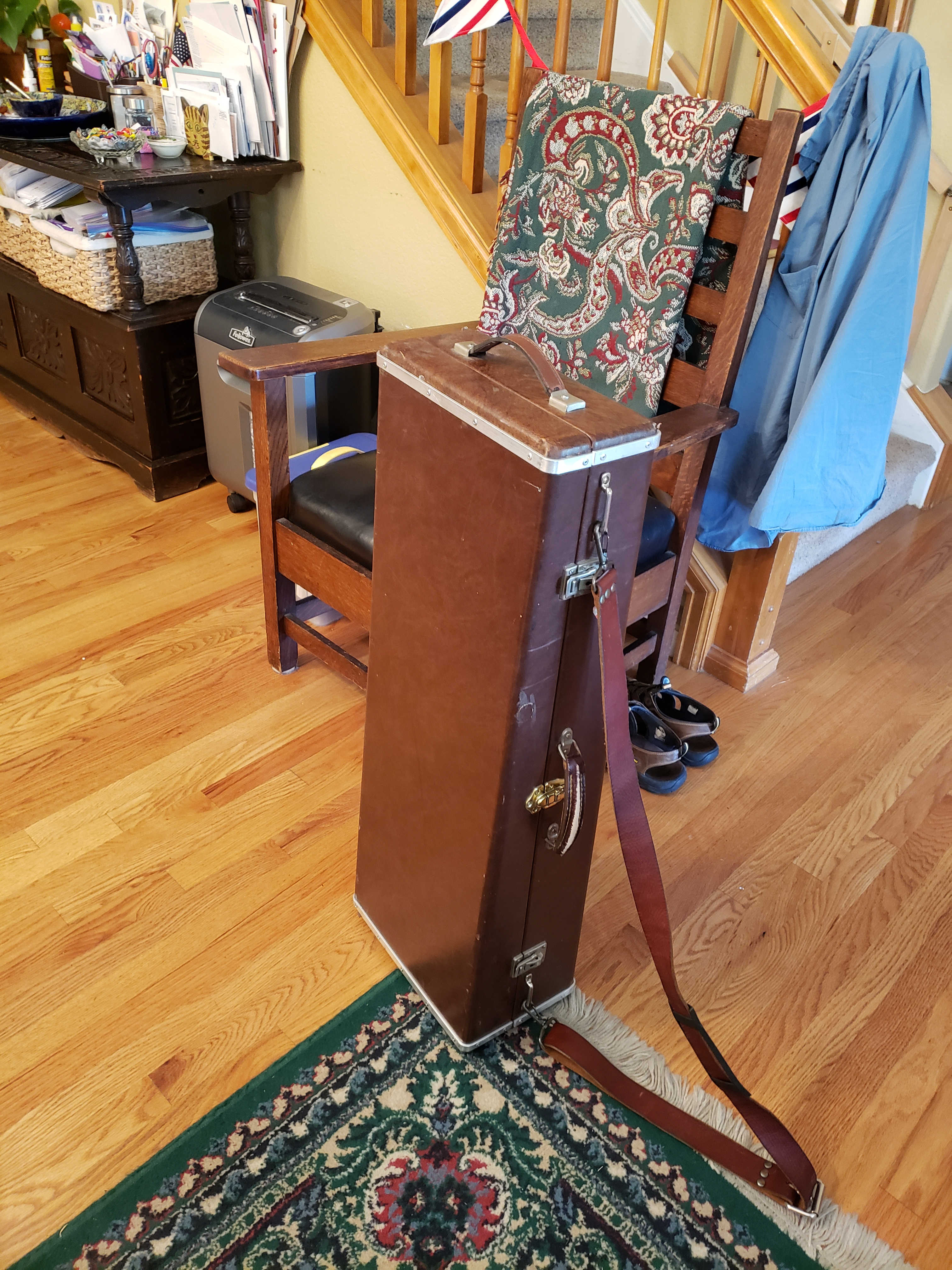 The bell section exterior looked clumsy and was closer to conical than to an exponential
flare. The external profile
of the bell was turned to make it more exponential in profile. This also had the benefit of making the instrument
a fraction lighter in the hand.
The crenellated brass bell-band was of very flimsy stock so a more solid one was fabricated.
The long back keys for C and D had their touchpiece ends set too low for a comfortable thumb position
for the right hand. So the pivot for those keys was moved up by 1 1/8". New extensions were
then made of brass so the 2 levers in the key mechanism met up. All key axles were replaced with sturdier
diameter brass.
The bell section exterior looked clumsy and was closer to conical than to an exponential
flare. The external profile
of the bell was turned to make it more exponential in profile. This also had the benefit of making the instrument
a fraction lighter in the hand.
The crenellated brass bell-band was of very flimsy stock so a more solid one was fabricated.
The long back keys for C and D had their touchpiece ends set too low for a comfortable thumb position
for the right hand. So the pivot for those keys was moved up by 1 1/8". New extensions were
then made of brass so the 2 levers in the key mechanism met up. All key axles were replaced with sturdier
diameter brass.
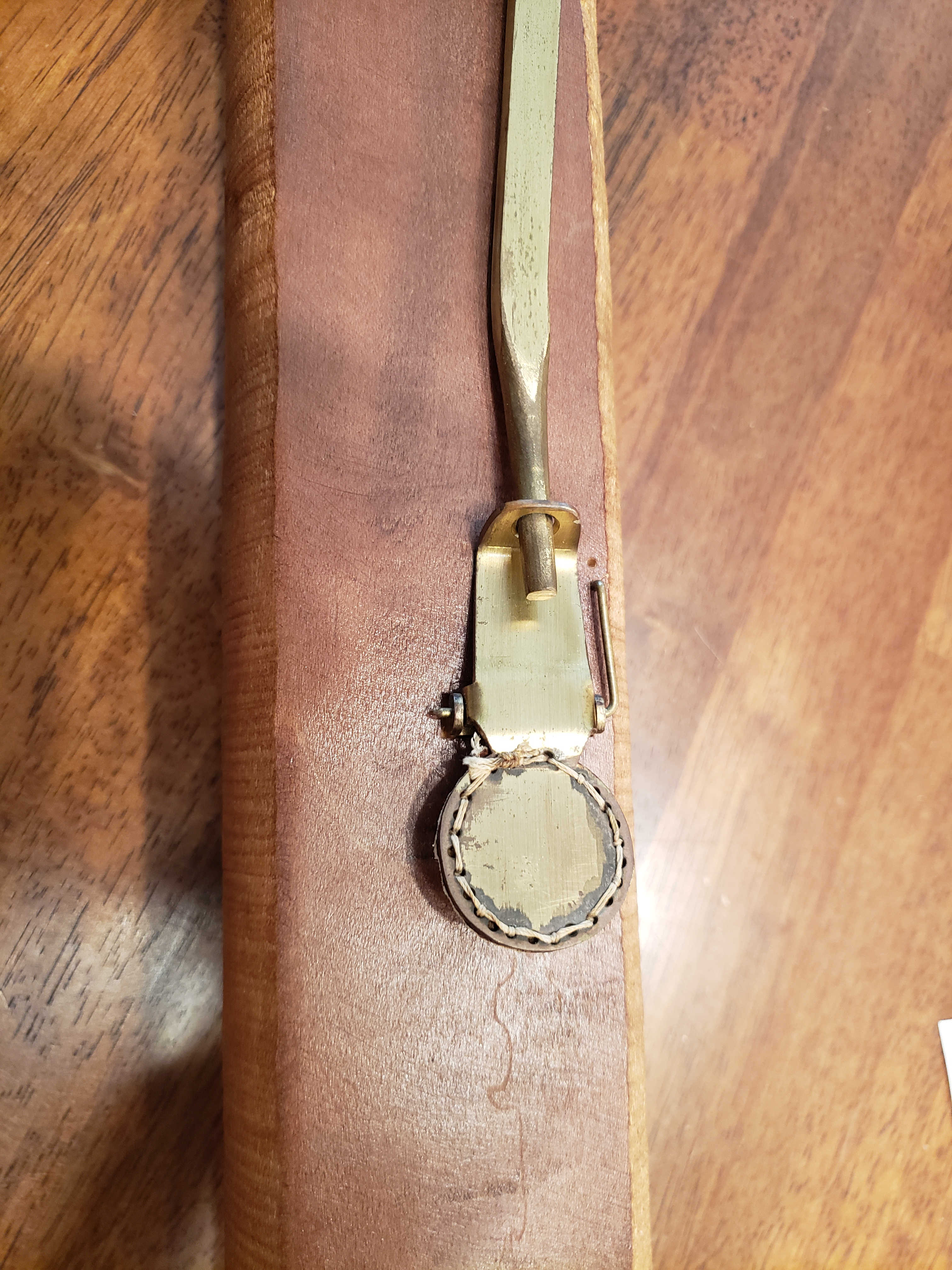 Keypads had been glued onto the key-flaps.
The glue was replaced by stitching more like old instruments.
Keypads had been glued onto the key-flaps.
The glue was replaced by stitching more like old instruments.
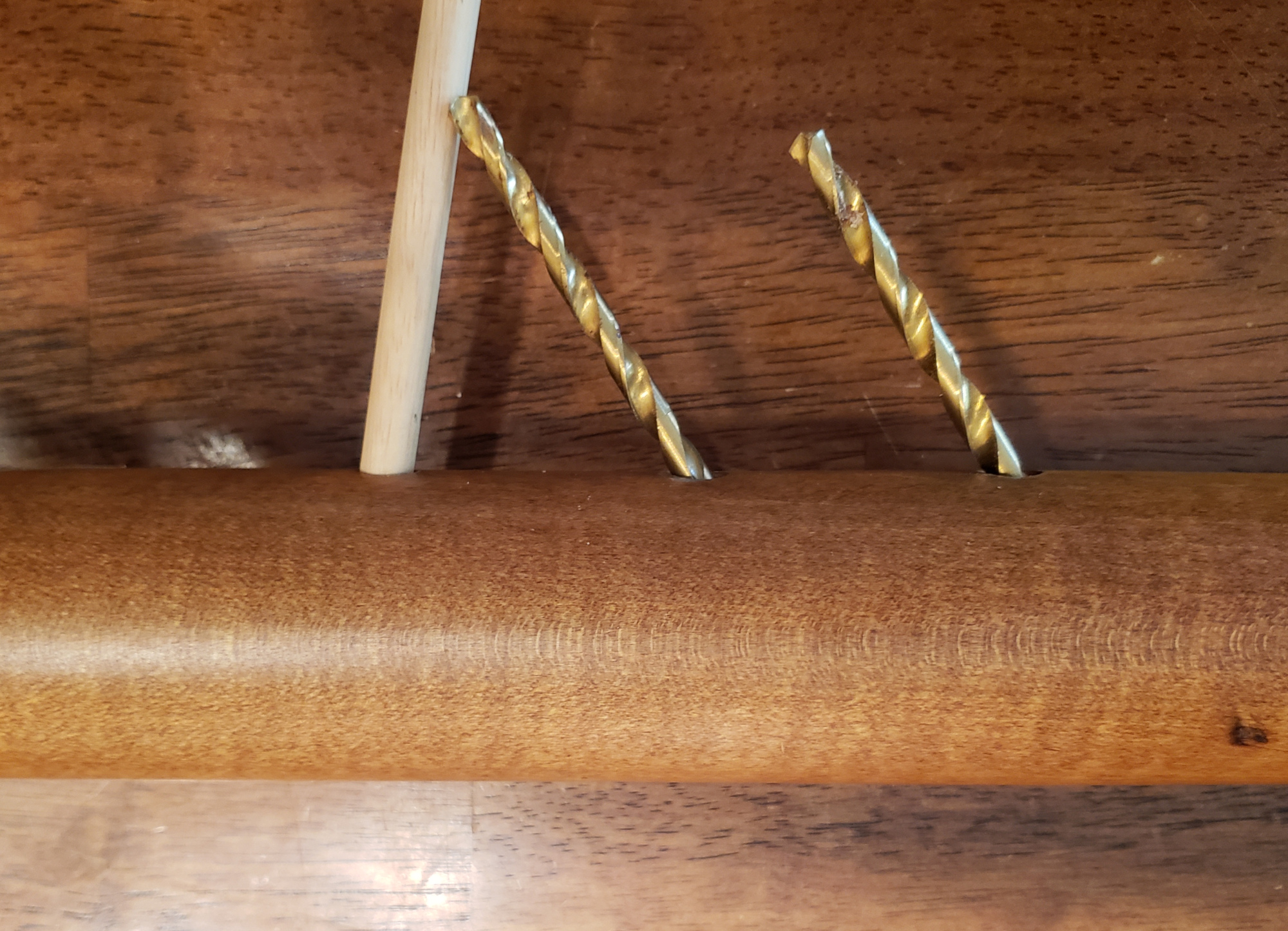 The 6th hole (A) seemed a bit high and the note b-flat (123 4.6) was quite unstable. The 6th hole was plugged
and redrilled with around a 30 degree angle towards the bottom. Likewise the 5th hole, so that b-flat can be played
using 123 4 (slightly high to suit meantone). The note b-natural plays with 123 4..7 or even 123 45.7
The 6th hole (A) seemed a bit high and the note b-flat (123 4.6) was quite unstable. The 6th hole was plugged
and redrilled with around a 30 degree angle towards the bottom. Likewise the 5th hole, so that b-flat can be played
using 123 4 (slightly high to suit meantone). The note b-natural plays with 123 4..7 or even 123 45.7
Some fingerings for high notes.
Convention in this table: 123 4567EDC is all holes covered and the lower
of the 2 compound keys are pressed. A "." is used as a place-holder for an open hole, or unpressed key.
| Note |
Fingering |
|
| e |
.23 ....... |
| g# |
123 45.7.DC |
| b |
123 45.7.D. |
| b (alternate) |
123 4.67.D. |
| c' |
123 4.67... |
Pirouettes for tenor shawms.
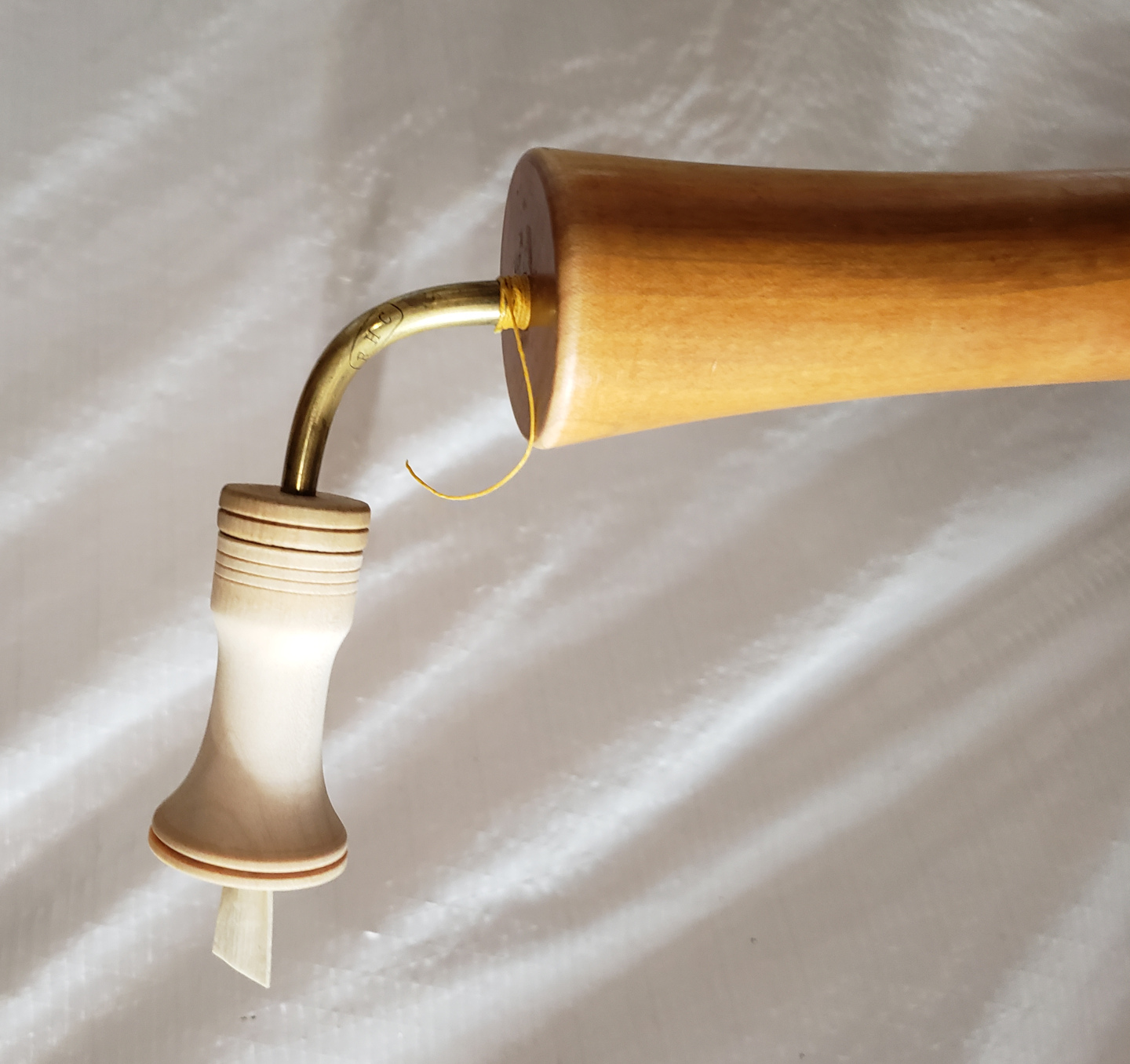 Modern makers, it seems, generally do not supply pirouettes on larger shawms despite Praetorius clearly
showing the tenor size (7-finger sounding c) having one (along with the smaller sizes
on the same page), and the bass beside it not having one.
Perhaps the confusion surrounding tenors and the niccolo "oddity" pursuaded
makers that the tenor pirouette was an engraving error too. Here is a pirouette made for a Cronin tenor.
Note too, that the sharp shoulder at the instrument top has been rounded a little and the crook has been bent more
from the supplied angle to allow a reed angle with the lips closer to 90o
Modern makers, it seems, generally do not supply pirouettes on larger shawms despite Praetorius clearly
showing the tenor size (7-finger sounding c) having one (along with the smaller sizes
on the same page), and the bass beside it not having one.
Perhaps the confusion surrounding tenors and the niccolo "oddity" pursuaded
makers that the tenor pirouette was an engraving error too. Here is a pirouette made for a Cronin tenor.
Note too, that the sharp shoulder at the instrument top has been rounded a little and the crook has been bent more
from the supplied angle to allow a reed angle with the lips closer to 90o
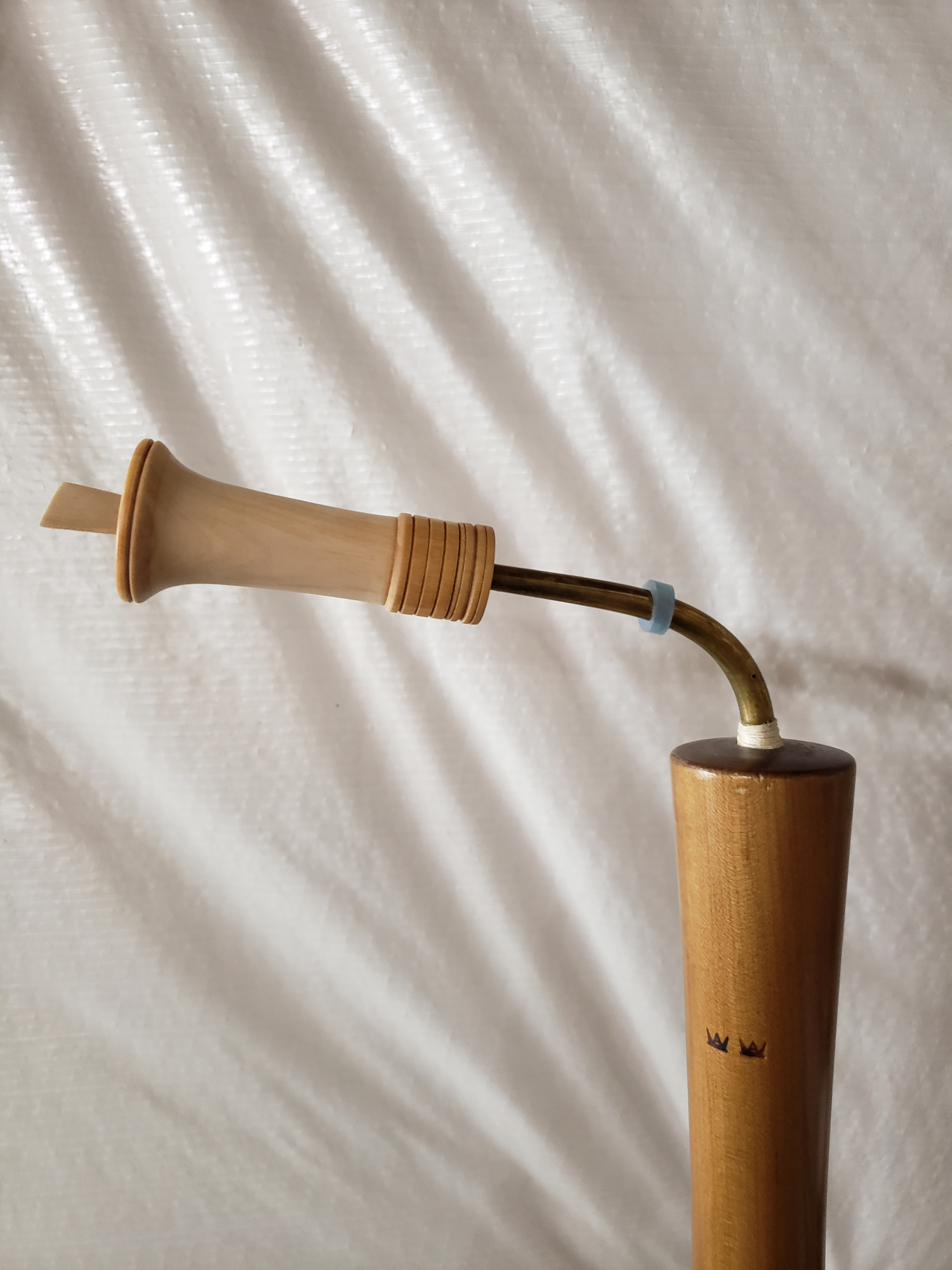 Image on left shows a Moulder tenor shawm
fitted with a pirouette.
Image on left shows a Moulder tenor shawm
fitted with a pirouette.

 The instrument was purchased at auction lacking a crook.
The first step was to have an instrument-maker make a crook, with a guess made as to the
needed length. The crook obtained resulted in the instrument playing quite sharp, so big reeds were
made to pull the pitch down somewhat. The lowest note C was a bit flat relative to
the general pitch so additional bell-hole drillings were tried to raise that note.
Some years later a "factory" crook was bought from Volker Kernbach
in Celle, which got the instrument closer to A=440.
The curvature of this factory crook was all
wrong (for me) so it was filled with Woods metal and bent to a more ergonomic curve.
The instrument was purchased at auction lacking a crook.
The first step was to have an instrument-maker make a crook, with a guess made as to the
needed length. The crook obtained resulted in the instrument playing quite sharp, so big reeds were
made to pull the pitch down somewhat. The lowest note C was a bit flat relative to
the general pitch so additional bell-hole drillings were tried to raise that note.
Some years later a "factory" crook was bought from Volker Kernbach
in Celle, which got the instrument closer to A=440.
The curvature of this factory crook was all
wrong (for me) so it was filled with Woods metal and bent to a more ergonomic curve.
 There was one tenon for disassembly located
above the fontanelle. This still left the lower 2/3 of the instrument in one piece.
A second tenon was created below the fontanelle to allow breakdown into 3 parts suitable for transport in a
smaller custom case.
There was one tenon for disassembly located
above the fontanelle. This still left the lower 2/3 of the instrument in one piece.
A second tenon was created below the fontanelle to allow breakdown into 3 parts suitable for transport in a
smaller custom case.
 The bell section exterior looked clumsy and was closer to conical than to an exponential
flare. The external profile
of the bell was turned to make it more exponential in profile. This also had the benefit of making the instrument
a fraction lighter in the hand.
The crenellated brass bell-band was of very flimsy stock so a more solid one was fabricated.
The long back keys for C and D had their touchpiece ends set too low for a comfortable thumb position
for the right hand. So the pivot for those keys was moved up by 1 1/8". New extensions were
then made of brass so the 2 levers in the key mechanism met up. All key axles were replaced with sturdier
diameter brass.
The bell section exterior looked clumsy and was closer to conical than to an exponential
flare. The external profile
of the bell was turned to make it more exponential in profile. This also had the benefit of making the instrument
a fraction lighter in the hand.
The crenellated brass bell-band was of very flimsy stock so a more solid one was fabricated.
The long back keys for C and D had their touchpiece ends set too low for a comfortable thumb position
for the right hand. So the pivot for those keys was moved up by 1 1/8". New extensions were
then made of brass so the 2 levers in the key mechanism met up. All key axles were replaced with sturdier
diameter brass.
 Keypads had been glued onto the key-flaps.
The glue was replaced by stitching more like old instruments.
Keypads had been glued onto the key-flaps.
The glue was replaced by stitching more like old instruments.
 The 6th hole (A) seemed a bit high and the note b-flat (123 4.6) was quite unstable. The 6th hole was plugged
and redrilled with around a 30 degree angle towards the bottom. Likewise the 5th hole, so that b-flat can be played
using 123 4 (slightly high to suit meantone). The note b-natural plays with 123 4..7 or even 123 45.7
The 6th hole (A) seemed a bit high and the note b-flat (123 4.6) was quite unstable. The 6th hole was plugged
and redrilled with around a 30 degree angle towards the bottom. Likewise the 5th hole, so that b-flat can be played
using 123 4 (slightly high to suit meantone). The note b-natural plays with 123 4..7 or even 123 45.7
 Modern makers, it seems, generally do not supply pirouettes on larger shawms despite Praetorius clearly
showing the tenor size (7-finger sounding c) having one (along with the smaller sizes
on the same page), and the bass beside it not having one.
Perhaps the confusion surrounding tenors and the niccolo "oddity" pursuaded
makers that the tenor pirouette was an engraving error too. Here is a pirouette made for a Cronin tenor.
Note too, that the sharp shoulder at the instrument top has been rounded a little and the crook has been bent more
from the supplied angle to allow a reed angle with the lips closer to 90o
Modern makers, it seems, generally do not supply pirouettes on larger shawms despite Praetorius clearly
showing the tenor size (7-finger sounding c) having one (along with the smaller sizes
on the same page), and the bass beside it not having one.
Perhaps the confusion surrounding tenors and the niccolo "oddity" pursuaded
makers that the tenor pirouette was an engraving error too. Here is a pirouette made for a Cronin tenor.
Note too, that the sharp shoulder at the instrument top has been rounded a little and the crook has been bent more
from the supplied angle to allow a reed angle with the lips closer to 90o
 Image on left shows a Moulder tenor shawm
fitted with a pirouette.
Image on left shows a Moulder tenor shawm
fitted with a pirouette.
